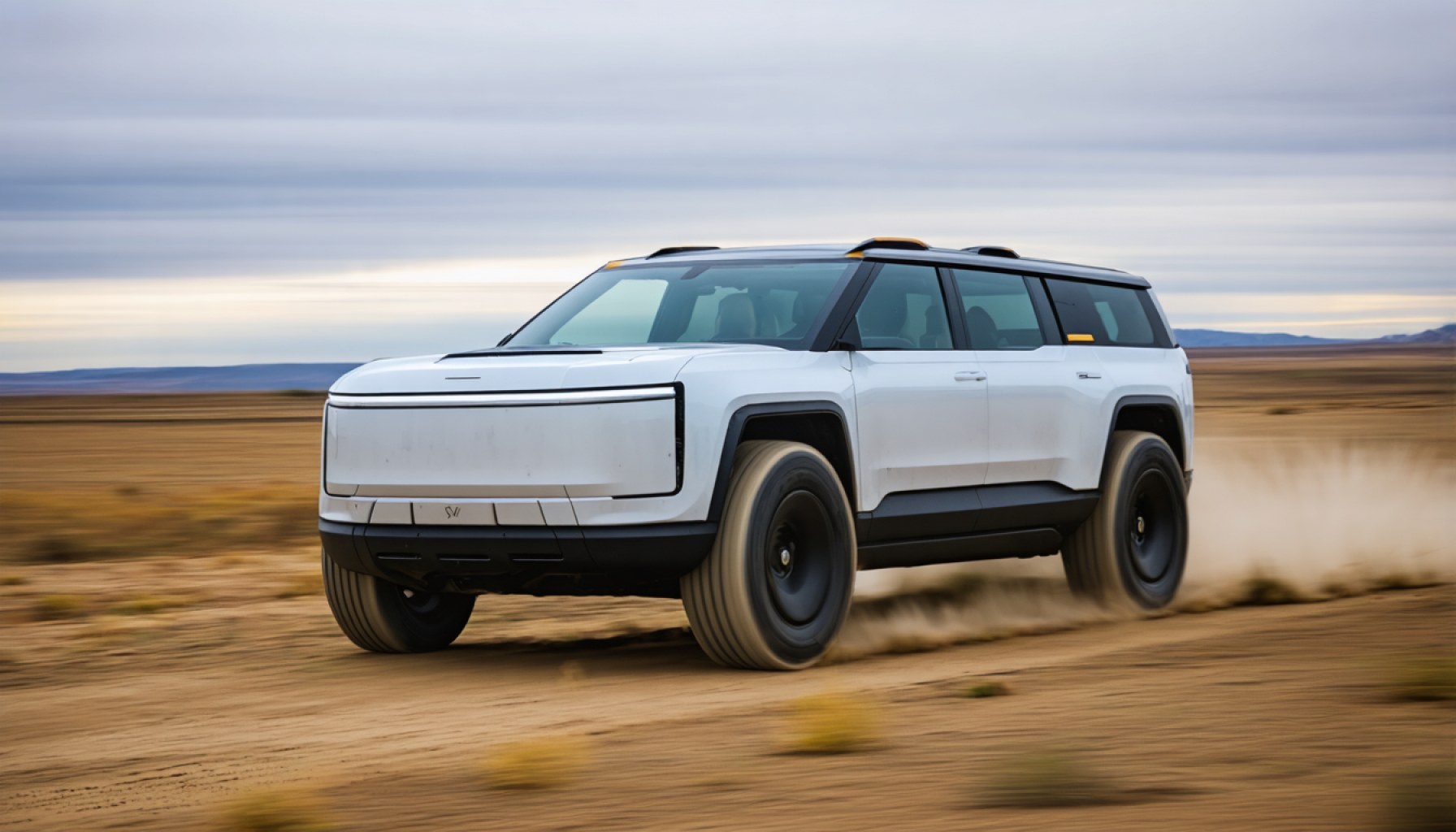- Rivian Automotive faced a challenging start to 2025, with stock prices dropping 5% after mixed first-quarter results.
- The company delivered 8,640 vehicles, surpassing forecasts of 8,200 but lower than last year’s 13,588, indicating decreased market demand.
- Consumer preference is shifting toward more affordable hybrids and gasoline vehicles, exacerbated by potential rising tariffs and California wildfires affecting EV demand.
- Rivian is optimistic about its future, planning an Illinois factory expansion and the launch of the competitively priced R2 model in 2026.
- The company aims for 46,000-51,000 deliveries in 2025, a significant challenge that could restore investor confidence if achieved.
- Investors are advised to remain cautiously optimistic, recognizing Rivian’s potential despite current market challenges.
The horizon seemed uncertain for Rivian Automotive as 2025 dawned, a year without the thrilling pulse of new launches or major market disruptions. The fresh-faced electric vehicle (EV) pioneer delivered its first-quarter numbers, a mixed batch that met analyst forecasts but left investors cold, leading to a swift 5% drop in its stock price.
In the first quarter, Rivian put 8,640 vehicles into the hands of eager drivers. While surpassing projections of 8,200, this figure fell dramatically short of last year’s 13,588—a 36% drop that pulsed like a red warning light. The company’s previous issues with supply chain bottlenecks were no longer the culprit, which directed a spotlight on the softer market demand.
Rivian’s current challenges span beyond production floors. Consumers are gravitating towards cheaper hybrids and traditional gasoline vehicles, a movement further intensified by threats of rising tariffs stemming from Rivian’s international supply chains. This, coupled with the tangible effects of California wildfires eroding demand in one of the country’s key EV markets, has stirred hesitancy among investors.
Yet, despite the early turbulence, Rivian pulses with potential. Its ambitious Illinois factory expansion is a burgeoning promise, a prelude to its much-anticipated R2 model slated for 2026. This vehicle, sliding under the $45,000 mark, tempts a broader consumer base, many of whom stand on the precipice of EV adoption but balk at the steeper price points of the R1 series.
For now, Rivian’s management remains resolute, aiming for 46,000 to 51,000 deliveries this year—a goal that hinges critically on the market’s reception across the coming quarters. Achieving this target would cushion the wavering investor confidence and reaffirm the company’s ambitious spirit.
Inconsideration of Rivian’s track this year—the takeaway for investors is cautious optimism. While 2025 might be a year of tempered growth, Rivian’s craftsmanship and upcoming models keep its future spark alive. Tuning expectations and maintaining a balanced portfolio may be prudent, but overlooking Rivian’s potential amidst its temporary detour could be an oversight for any future-focused investor.
Rivian’s Path Forward: Navigating Challenges and Unleashing Potential
Rivian: Current Landscape and Future Expectations
Rivian Automotive has carved a niche in the electric vehicle (EV) market but faces a challenging 2025. Despite meeting first-quarter expectations by delivering 8,640 vehicles, this figure is a stark 36% drop from the 13,588 vehicles delivered in the same period last year. A deeper look shows that Rivian is grappling with softer market demand rather than persistent supply chain issues.
Additional Insights Into Rivian’s Current Situation
Market Dynamics:
– Consumer Preferences: There is a shift towards more affordable hybrids and traditional gasoline vehicles, a trend intensified by geopolitical concerns like potential rising tariffs impacting Rivian’s international supply chains.
– Environmental Impact: The impact of recent California wildfires has notably dampened EV demand in one of Rivian’s key markets, affecting their sales strategy in that region.
Rivian’s Strategic Initiatives
Illinois Factory Expansion:
Rivian’s expansion in Illinois is set to ramp up production, with a focus on introducing the R2 model in 2026. This model aims to appeal to a broader audience with a price point below $45,000, potentially capturing consumers hesitant to invest in the higher-priced R1 series.
2023 Delivery Targets:
The company is targeting 46,000 to 51,000 vehicle deliveries in 2023. Critical market reactions in the upcoming quarters will determine the feasibility of this ambitious target.
How-To Improve and Prepare
1. Investment Strategy:
– Evaluate your portfolio with caution, considering Rivian’s potential amidst its current market challenges. This could involve balancing investments in traditional vehicles with EV stocks like Rivian’s.
2. Market Trends & Forecasts:
– Stay informed of geopolitical developments that may affect tariffs and EV component costs.
– Monitor environmental policies that could influence EV adoption, particularly in regions like California.
3. Broader Adoption Initiatives:
– Encourage awareness of EV incentives available at the state and federal levels that could ease the transition to electric vehicles for consumers.
Industry Trends and Predictions
– Growth in Affordable EVs:
Expect an increase in the production of mid-range EV models as competition heats up.
– Sustainability Focus:
Anticipate greater emphasis on sustainable production practices and eco-friendly components as consumer consciousness about environmental impacts rises.
Quick Tips for Potential EV Consumers
– Evaluate Costs:
Consider total cost of ownership, including incentives, charging infrastructure, and maintenance. Tools like Edmunds offer valuable resources.
– Stay Informed:
Join automotive forums and follow blogs like MotorTrend for the latest insights and reviews.
Conclusion: Prospects and Cautions
Rivian presents a blend of potential and cautionary tales in the evolving EV landscape. Its planned innovations, commitment to expansion, and upcoming vehicle models suggest a promising future. However, careful navigation of the current market challenges will be crucial. Investors and consumers alike should keep an eye on Rivian’s strategic moves, balancing optimism with prudence as Rivian repositions itself for growth.










